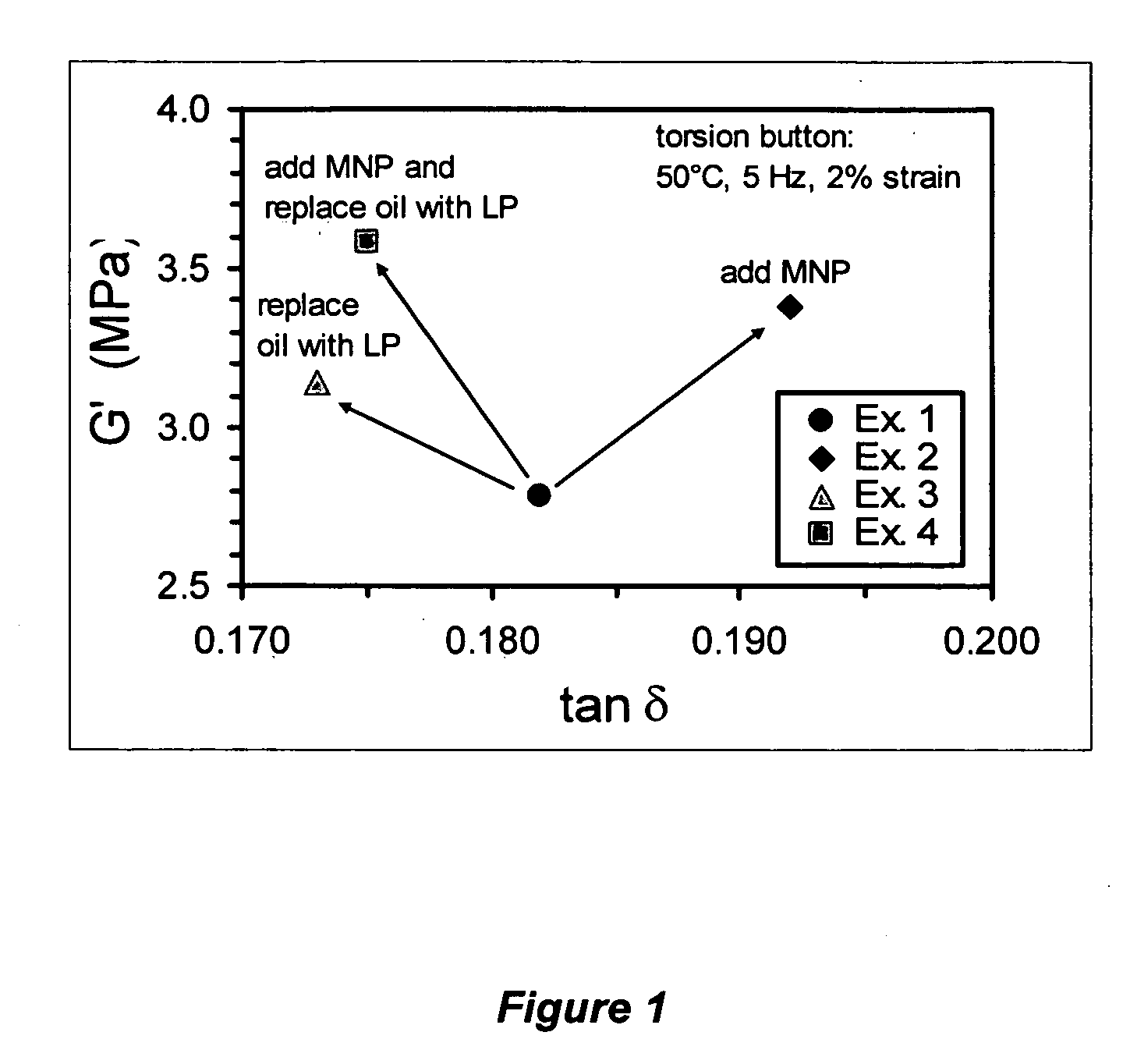Combined use of liquid polymer and polymeric nanoparticles for rubber applications
- Summary
- Abstract
- Description
- Claims
- Application Information
AI Technical Summary
Benefits of technology
Problems solved by technology
Method used
Image
Examples
example a
The Synthesis of Micelle Nano-Particles
[0102] A 2-gallon reactor was used. Butadiene in hexane blend (21.9 weight percent butadiene), styrene in hexane (33 weight percent styrene), hexane, n-butyl lithium (1.54 M), OOPS modifier (1.6 M), isopropanol and BHT were used as supplied. Divinylbenzene was purchased from Aldrich (80% divinylbenzene) and stored on alumina beads and calcium hydride.
[0103] The reactor was charged with 4.80 lbs hexane and 3.98 lbs of the butadiene in hexane blend. The jacket of the reactor was heated to 165° F. When the batch reached 153° F., 2.5 mL of 1.54 M n-butyl lithium were added, diluted with about 20 mL of hexane. The polymerization exothermed at 191.7° F. after 14 minutes of reaction. After ½ hour, the jacket of the reactor was set to 100° F. A sample was dropped for analysis. Some n-butyl lithium (7.5 mL) was added. A mixture of styrene blend (349.2 g) and DVB (45.5 mL) was prepared in a bottle and added to the reactor. The jacket temperature of the...
example b
The Synthesis of a Liquid Polymer
[0105] A 2-gallon reactor was used. Butadiene in hexane blend (21.4 weight percent butadiene), hexane, n-butyl lithium (1.60 M), OOPS modifier (1.6 M), isopropanol and BHT were used as supplied.
[0106] The reactor was charged with 2.99 lbs hexane and 7.00 lbs butadiene in hexane blend. The jacket of the reactor was heated to 140° F. When the batch reached 113° F., 5.3 mL of 1.60 M n-butyl lithium were added, diluted with about 20 mL of hexane. The polymerization exothermed at 177.9° F. after 33 minutes of reaction. After 1 hour, the temperature was brought down and the mixture was dropped in isopropanol containing BHT. The solvents were then removed through evaporation and drying in a vacuum oven.
[0107] Measurement using GPC indicated that the liquid polymer had an average molecular weight of 80K, (80 kg / mol)
examples 1-4
Compounding
[0108] A matrix polybutadiene obtained from Firestone Polymer Company under Trade name HX301 was used. The matrix polybutadiene had a molecular weight of about 150,000, a 12% vinyl butadiene and a 40 Mooney viscosity. Rubber compositions were prepared according to Table 4 under the conditions shown in Tables 1-3. In the formulations, the amounts of matrix rubber, aromatic oil, micelle nano-particles, and liquid polymer were varied. The synthesized nano-particle from Example A was selectively used to replace 15 phr of the matrix polubutadiene in the compound formulation (Example 2). The synthesized nano-particle from Example A was selectively used to replace 15 phr of the matrix polubutadiene and the liquid polymer from Example B was sused to replace the aromatic oil (Example 4). Two controls (i.e., Example 1 and 3) were used for setting up a comparison with the test compounds. One was the conventional formulation (Example 1); and the other (Example 3) was the formulation...
PUM
| Property | Measurement | Unit |
|---|---|---|
| Temperature | aaaaa | aaaaa |
| Diameter | aaaaa | aaaaa |
| Diameter | aaaaa | aaaaa |
Abstract
Description
Claims
Application Information
 Login to View More
Login to View More - R&D
- Intellectual Property
- Life Sciences
- Materials
- Tech Scout
- Unparalleled Data Quality
- Higher Quality Content
- 60% Fewer Hallucinations
Browse by: Latest US Patents, China's latest patents, Technical Efficacy Thesaurus, Application Domain, Technology Topic, Popular Technical Reports.
© 2025 PatSnap. All rights reserved.Legal|Privacy policy|Modern Slavery Act Transparency Statement|Sitemap|About US| Contact US: help@patsnap.com



